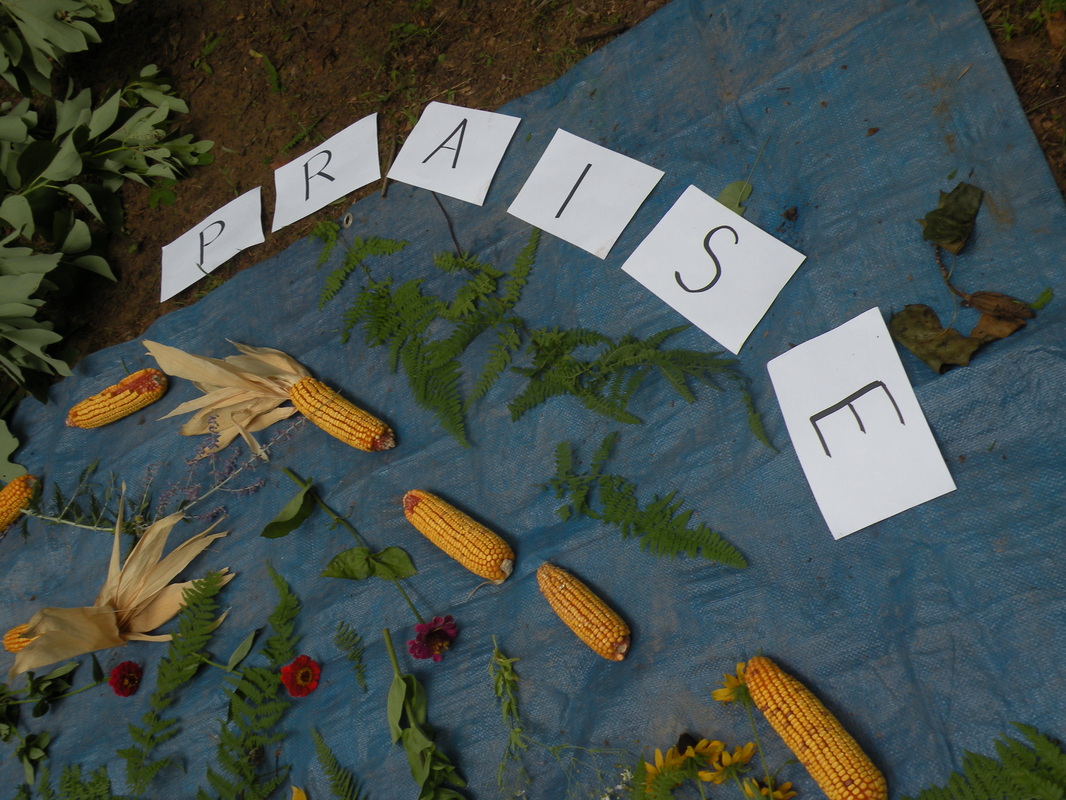Paleo-Preservation Initiative BLUEMONT, VA – Local students and family from three local churches learned more about Native American culture and the Paleo-Indian concentric rings found in here through a July 9 “Art in Nature” ™ class held by the Native American Church of Virginia. Students and families ages 6 to 73 arrived from three corners of Northern Virginia to share in this unique physical and spiritual art experience. Eight members from the Bluemont United Methodist Church; seven members from the Emmaus Church of Berryville; and one member from the Fairview Methodist Church in Stephens City participated. Led by Native American of Virginia artist René White (Feather), a retired Air Force veteran, the class revolved around the letters P-R-A-I-S-E as a tool to study the Paelo-Indian concentric rings. Her husband Chris (Comewithclouds) discovered the Paleo-Indian site in 2010 while looking for a spot on their land to build a Native American medicine wheel. Last use of the Paleo-Indian rings dates to 10,740 years ago based on recent anthropology luminescence dating of an excavated artifact. “My goal with this Paleo-preservation class is to help build comprehension of the process of exploration and to gain an understanding and appreciation of Paleo-Indian culture and see how ancient people lived in balance with nature thousands of years ago, without cell phones and television,” René said. P-R-A-I-S-E “I used the letters in PRAISE to help explain the ideas of Purpose, Research, Analysis, Implement, Strategize and Evaluate in a physical, spiritual and FUN art experience outdoors,” said René who is the Native American Church of Virginia president. P - Purpose The class began as Chris, CEO of the Native American Church of Virginia, led the group in prayer. Sitting on red, white and blue blankets René explained the class “Purpose:” to create “Art in Nature” to leave outside for Creator God and to PRAISE & worship together. R - Research After a quick “go song” on the flute by René, the group began their “Research” to find natural materials to create their PRAISE art in nature piece. Using baskets, bowls and scissors they collected arm loads of fern, cut beautiful flowers and fragrant plants, and gathered unusual rocks as they hiked a small portion of the Blue Ridge Mountain eating raspberries along the way. A - Analysis The “Analysis” activity took place around a blue tarp near the sacred Paleo-Indian site and along the Spout Run creek, where students laid down their pickings and separated all the mixed up textures and colors into separate piles. One student even carried in a huge branch downed by last night’s storm. I - Implement The objective was to “Implement” the art project by spreading out all the items into concentric rings, similar to what the Paleo-Indian’s left behind. René established the midpoint of the rings by placing a thin slice of black walnut shell in the center of a dried walnut trim gourd with a streamer going out in the direction of the water flowing down the creek towards the Shenandoah River. The students placed everything from a pile of carrots and corn to feathers and ferns into the spiral of rings. As they took turns, René reminded them that the “I” in implement also stands for good “Intent.” S- Strategize To “Strategize” the children advised each other on how to lay their items, determined which items to place in the gourd bowl and agreed to keep the red carpets (that Chris laid) open to the East and the rising sun. | Sitting on red, white and blue blankets René explained the class “Purpose:” “I was glad to be part of bringing the church kids to the Paleo site,” said Bluemont resident Susan Freis Falknor. “The Whites have made such an exciting discovery and it’s great that these local children are among the first to know about it.” “What sticks out in my mind about the art class was that the children were able to slow down and closely observe natural forms, like ferns, sticks, stones, dried ears of corn. Under the soft green light of the wooded mountainside, the colors of the everyday objects that they arranged on the tarp in concentric rings seemed to glow.” After a group photo showing the completed work, children explored in the creek and gathered lunch: a watermelon and cantaloupe cooling in the creek. They relaxed a few minutes on a bridge eating and just enjoying nature and their new friendships before the class finished. “In addition to saying thanks and acknowledging elements of creation, by creating Art in Nature and leaving it here, I think this exercise teaches the principles of humility, giving of self, and non-attachment,” said Chris. E - Evaluation During the “Evaluation” phase, they climbed to a nearby ridge looking back down at their work of PRAISE. Then each participant spoke about their discoveries to the rest of the group in a brief report. Several were shy, but still took their turn to speak before the group. “Speaking in front of each other allows them to feel how good it is to get up and acknowledge the experience of letting a creative project bring them together,” said René. “And I think it gives them courage to want to say more next time.” Special thanks to Claudia DeLancey of Winchester VA for volunteering to be the official photographer for the event. _________________________________ The Native American Church of Virginia is a 501(c)3 compliant non-profit located at a Sanctuary on the Trail™ near Bluemont, Virginia, and raises money to help preserve, protect and restore a Paleo-Indian site the family found on the property in Northern Virginia. Their mission work includes helping reduce suffering in the world, helping wounded warriors and elders by helping leaders first. For more about the Native American Church of Virginia, the sacred Paleo-Indian ceremonial site or Art in Nature™ find out more online at these locations: Related Articles: |
|
0 Comments
Your comment will be posted after it is approved.
Leave a Reply. |
Paleo News Room
for the site discovered by Chris (Comeswithclouds) White in 2010 Topics
All
History
August 2020
|


 RSS Feed
RSS Feed